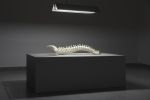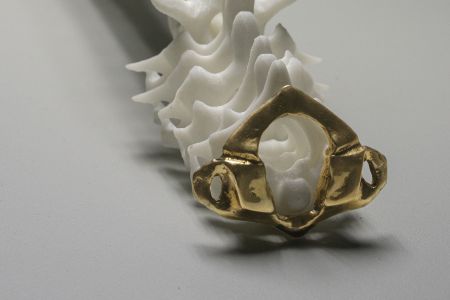The Serpent: Difference between revisions
No edit summary |
No edit summary |
||
| (17 intermediate revisions by the same user not shown) | |||
| Line 2: | Line 2: | ||
| title = The Serpent | | title = The Serpent | ||
| year = [[2022]] | | year = [[2022]] | ||
| height_metric = 20 | | height_metric = 20 | ||
| width_metric = 110 | | width_metric = 110 | ||
| length_metric = 20 | | length_metric = 20 | ||
| | | medium = [[PLA]], [[Bronze]] | ||
| image = Equinox1143-Edit.jpg | | image = Equinox1143-Edit.jpg | ||
| image_upright = 0.5 | | image_upright = 0.5 | ||
| image_file = Equinox1143-Edit.jpg | | image_file = Equinox1143-Edit.jpg | ||
}} | }} | ||
'''''The Serpent''''', Is a [[sculpture]] made in [[2022]]. | '''''The Serpent''''', Is a [[sculpture]] made in [[2022]] part of the solo exhibition ''[[Equinox]]''. | ||
The spine or serpent column is derived from a database of CT and MRI scans used for medical research purposes, and it is 3D printed using PLA. In contrast, the atlas bone, which supports the skull, is crafted from bronze. The model is created in sections through 3D printing and then manually assembled. This process adds an additional layer of translation, compression, and interpretation as it moves from the physical to the digital realm and back to the physical. Each conversion introduces changes or imparts new attributes to the conveyed material. | |||
The atlas bone is named after the Titan who bore the weight of the world on his shoulders, symbolizing the world, consciousness, or the soul. According to this concept, it is positioned at the top of every individual's spine and can be viewed as a stance against the duality of body and soul. | |||
In Jewish tradition, this bone is also known as the "Luz bone," and it is believed to remain intact for many years after burial. It is said to play a role in the resurrection of the dead, serving as a nucleus for the complete reconstitution of the person, including their consciousness. This raises the question of why provide a mechanistic solution to the divine phenomenon of the resurrection of the dead when it could be stated equally that the body rises and is recreated ex nihilo (out of nothing). | |||
File: | |||
In the Zohar, this bone is referred to as the "Batuel Ramah" in a loose translation from Aramaic, meaning "Bethuel the cheater," due to its serpent-like shape. This reference harks back to the primordial serpent, "the Cheater," which tempted Eve to eat from the Tree of Knowledge.<gallery mode="packed-hover" heights="200"> | |||
File: | File:Equinox1150-Edit.jpg | ||
File:Equinox1155-Edit2.jpg | |||
</gallery> | </gallery> | ||
[[Category:2022]] | |||
[[Category: | [[Category:Works]] | ||
[[Category:Bronze]] | |||
[[Category:3D Printing]] | |||
Latest revision as of 16:39, 5 December 2023
| The Serpent | |
|---|---|
 | |
| Year | 2022 |
| Medium | PLA, Bronze |
| Dimensions | 20 cm × 110 cm × 20 cm (7.9 in × 43 in × 7.9 in) |
The Serpent, Is a sculpture made in 2022 part of the solo exhibition Equinox.
The spine or serpent column is derived from a database of CT and MRI scans used for medical research purposes, and it is 3D printed using PLA. In contrast, the atlas bone, which supports the skull, is crafted from bronze. The model is created in sections through 3D printing and then manually assembled. This process adds an additional layer of translation, compression, and interpretation as it moves from the physical to the digital realm and back to the physical. Each conversion introduces changes or imparts new attributes to the conveyed material.
The atlas bone is named after the Titan who bore the weight of the world on his shoulders, symbolizing the world, consciousness, or the soul. According to this concept, it is positioned at the top of every individual's spine and can be viewed as a stance against the duality of body and soul.
In Jewish tradition, this bone is also known as the "Luz bone," and it is believed to remain intact for many years after burial. It is said to play a role in the resurrection of the dead, serving as a nucleus for the complete reconstitution of the person, including their consciousness. This raises the question of why provide a mechanistic solution to the divine phenomenon of the resurrection of the dead when it could be stated equally that the body rises and is recreated ex nihilo (out of nothing).
In the Zohar, this bone is referred to as the "Batuel Ramah" in a loose translation from Aramaic, meaning "Bethuel the cheater," due to its serpent-like shape. This reference harks back to the primordial serpent, "the Cheater," which tempted Eve to eat from the Tree of Knowledge.


